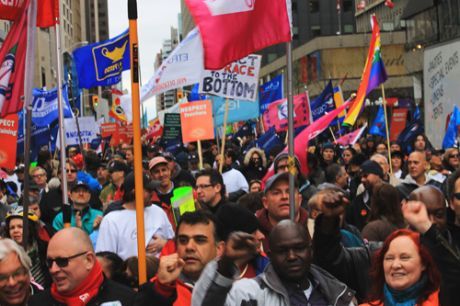What we think
You are here
Ontario budget

April 23, 2012
After students occupied and workers demonstrated against austerity, the Ontario NDP have supported McGuinty’s budget and missed a chance to build the movement against the 1%.
NDP leader Andrea Horwath claimed victory, avoiding an election and getting Liberal Premier Dalton McGuinty to raise taxes on the wealthiest. But McGuinty has played a shell-game: “The richest Ontarians…would be asked to pay a two per cent surtax, which would generate $470 million next year, all of which would go into reducing the deficit.”
In other words, tax the rich then hand it over to the banks.
The other concessions—$242 million for child care, $20 million for Northern Ontario hospitals, and $55 million for social assistance (a meager 1 per cent increase in monthly support, against a 2.2 per cent inflation rate last year alone)—will be paid for by moving money from other line items like education and health care. Because these figures don’t reflect new spending, and because the $470 million in new tax revenue will be paid directly to the banks to reduce the deficit, there is no impact at all in McGuinty’s plan to cut $10 billion from public services. In short, the Liberal/NDP deal leaves McGuinty’s austerity program entirely untouched.
Referendum on austerity
What was the alternative? Had the NDP voted down the budget they could have triggered an election as a referendum on austerity, on their terms of debate. Taxing the rich is wildly popular, with 78 per cent of Ontarians supporting it, and Horwath’s popularity surging at the mere mention of taxing the 1%. The NDP could have increased their 23 per cent share of the vote by leading a fight against austerity, sidelining both Tories and Liberals, and combining the ballot box with the streets.
Instead, the NDP leadership counter-posed and undermined both, avoiding a referendum on austerity and supporting the austerity budget. According to Horwath: “I feel that we serve the public better by getting to work here in this legislature than chasing votes in an election.” By reducing elections to “chasing votes” the NDP missed an opportunity to use the election to campaign against austerity, and instead joined the legislature in supporting it.
Missing the orange wave and the Occupy movement
In the context of the economic crisis, the Arab Spring and the Wisconsin occupation, last year’s historic “orange wave” that catapulted the federal NDP into Official Opposition showed people’s hopes for a real alternative—despite the NDP’s modest platform. But the NDP leadership drew the opposite conclusion: that they needed to campaign to the centre. In Toronto, Tories were stopped by a mass grassroots campaign that reversed the tide against Rob Ford and derailed Hudak’s campaign. But the NDP didn’t reflect this anti-austerity mood in the election. The result: the lowest voter turnout in Ontario history, with no change to the combined Tory-Liberal vote, and the NDP only gaining votes from the greens.
The apathy towards mainstream politics was juxtaposed to the inspiring Occupy movement that exploded at the same time. This came from, and contributed to, the mood to fight the austerity agenda of the 1%, like McGuinty’s budget.
Students delivered 40,000 petitions to cut tuition fees in January, organized a national day of action in February, and occupied education minister Glen Murray’s office in early April—inspired by Quebec’s historic student strike. Two days ago, up to 20,000 workers from across Ontario demonstrated at Queen’s Park demanding not only higher taxes on high incomes, but also higher taxes on banks and corporations.
Despite the NDP supporting the austerity budget, the movements outside the legislature have not gone away, and will be key to challenging austerity in the weeks and months to come.
Section:
Topics:
- Log in to post comments










